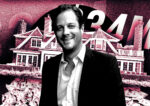Bogged down by pricing that remains out of sync with plunging property values and buyers expecting great deals, the $1 million-plus luxury market in South Florida moves at a trickle compared to lower priced homes.
Even realistically priced but expensive homes sit on the market for twice as long as homes in the $300,000 and under range, due mostly to the battering of the stock market and sagging economy — and topped off by a tough financing climate. Together, that’s taken plenty of prospective buyers out of the equation.
One doesn’t have to look far to find examples of luxury homes that aren’t selling. A 10,000-square-foot Intracoastal home in Boca Raton has been on the market for two years. The seller dropped the price several times — from $12 million to $7.1 million.
Only a few prospective buyers have shown a glancing interest, brokers said.
Another home in Hollywood Beach listed for $1.3 million has no offers. “The house is worth the mid-$800s to low $900s, based on my analysis,” said Michael Humphries, a realtor with Coldwell Banker in Cooper City. “But it was worth $1.6 million in 2005, and it’s difficult to swallow, to say, ‘My house is now only worth $900,000.'” The seller does not plan to renew the listing when it expires this summer, Humphries said.
Many business owners who traditionally bought houses in the $1 million-plus bracket now struggle to keep their stores or small manufacturing operations open, said Sheldon Jaffee, an estate agent with Lang Realty in Boca Raton who covers the $1 million-and-up market.
“The small businessman who owned a business on Federal Highway for the past 10 years, he is out now,” Jaffee said. “And that’s who is able to buy a home for a million dollars. It’s not the person making a salary.”
Those buyers who are still in the game are paying all cash and expecting deep discounts. Jaffee is working with a few out-of-state entrepreneurs and retirees. They are either waiting patiently for prices to come down or going after foreclosures. “Foreclosures are starting to creep into those areas it never hit before,” Jaffee said.
But there is a faint hint of good news. After eight months with the inventory of homes either increasing or staying stagnant, the luxury market in Miami-Dade, Broward and Palm Beach counties finally saw an uptick in sales in May, Multiple Listing Service statistics show.
The movement is a trickle compared to the rapid sales pace of homes in the lower price ranges.
In Dade County, sales and pending sales in the $1 million-plus bracket were up slightly in May from April’s numbers, but still 33 percent shy of sales and pending sales a year and a half ago. The 55-month supply of homes was still higher than the 48-month supply from March 2008.
Meanwhile, the supply of $1 million-and-under homes shrank by more than half — from a 45-month supply in March 2008 to a 19-month supply in May. Sales and pending sales in the lower price range jumped by 76 percent.
Luxury homes in Miami-Dade stayed on the market an average of 188 days in May, compared to 111 days for homes under $1 million.
In Broward, the $1 million-plus inventory decreased for the first time in months. Sales and pending sales in the $1 million-plus range increased by 44 percent, but were still nowhere close to sales a year and a half earlier. Luxury homes were on the market for an average of 222 days — more than double the average for homes in the $300,000-and-under price range.
Across Palm Beach County, sales showed a modest increase and there was a dent in the inventory. There were 118 sales and pending sales in March 2008 compared to 88 in May.
“The recovery has not started to reach us yet,” Jaffee said.
The higher-end market, which typically transitions more slowly because of the smaller pool of buyers, still has a long way to go. Prices have to come down more before inventory really starts to decrease, Humphries said.
Because buyers of luxury homes are closely tied to the actions of the stock market, Humphries said a lot depends on what happens on Wall Street and with consumer confidence this summer.
“If it starts to go down, we can see another double-digit decrease in prices,” Humphries said.
Jaffee said the luxury market is the slowest he has seen since 1981, when interest rates were 20 percent. He is also watching the stock market. “If the stock market recovers, then everyone has better cash flow. If it takes another dip this summer the way they say it might, we could end up a W instead of a V recovery.”



